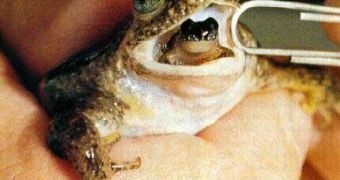There's nothing impressive in this Australian frog: dull coloration and just up to 5.5 cm (2.2 in) in length. But the Rheobatrachus frogs, first described in 1973, are nothing ordinary. Their name of gastric-brooding frogs speaks about an amazing breeding behavior in this species.
While keeping them in an aquarium, researchers were taken totally by surprise to see how one of the frogs opened her mouth and started to spit out froglets: 11 offspring in 50 minutes. Next day, the mother spat out another 15 offspring. The 26 froglets made 40 % of the body weight of their mother.
These frogs swallow their eggs after being spawn on the soil and fertilized by the male. The gastric gestation lasts 6-8 weeks, a period when the mother's stomach is swelling enormously. The female does not eat during this period, living on her own reserves. The lungs can no longer function due to the distorted stomach, and breathing is made exclusively through the skin. The gastric brooding increases the survival chances of the offspring: they are not exposed to predators or to the drying of the pool in which they live.
The puzzle is how the chlorhydric acid and digestive juices of the stomach do not destroy the eggs and the developing embryos. One hypothesis is that a part of the swallowed eggs sacrifice themselves for the development of the others, and during their break down, they release a chemical that blocks the hormone that determines the acidity of the gastric juice. That chemical was even detected: a prostglandin called PGE2, proved to be stable at temperatures varying between 30o C and -20oC.
Only two species of gastric brooding frogs WERE known from northeastern Australia, in an area of less than 2000 km? (800 mi?), in creek systems in rainforests between 350 - 1400 m (1100 - 4600 ft). By the mid 80's, both species disappeared, due to not clearly understood reasons. Hypotheses include habitat loss and degradation, pollution, and the amphibian Batrachochytrium dendrobatidis fungus.

 14 DAY TRIAL //
14 DAY TRIAL //